Among the most sought-after decorative garden crops, which are used to design a nursery or cottage, are evergreens coniferous trees or shrubs. There is a huge number of incredibly beautiful species and varieties of coniferous plants to create a unique and beautiful landscape design. In particular popularity of summer houses and gardeners. This is a beautiful evergreen coniferous plant from the cypress family. A bright representative of this family is the Thuja Western grade amber, which attracts a thick dense crown of golden color. How to grow a sharp amber and correctly use a conifer to create beautiful compositions in the garden, read in this article.
Thuja Amber: Description
Thanks to the painstaking work of breeders, a new grade of Tui Western Amber was replaced. Such a name variety was not accidental. The needle of Tui Amber is painted in a bright yellow shade, which with the arrival of winter acquires a warm amber sampling. The coniferous tree with a luxurious yellow crown cannot be noticed in the garden. This variety is spectacularly distinguished against the background of other evergreen coniferous crops, shrubs and trees. His decorative retains all year round.
Distinctive features of the Tui Amber
- The coniferous tree has a narrow, conical shape of the crown. The average height of the car from 3 to 5 meters, in width up to 1.2 meters. The variety is characterized by slow growth. For the year, the thuja will grow by about 20 cm. The decade of the village reaches a height of up to 2 meters.
- The needles of Tui amber dense, thick, slightly directed outward, scaly. With the onset of cold weather, its saturated yellow shade becomes amber.
- Flat and branched shoots are destroyed, directed outward. At the end of the short side shoots of the tree are formed small yellowish-green cones. After ripening, the bumps become brown, reaching the length from 8 to 12 mm. In cones, narrow small seeds ripen.
- The bark of the tree is brown, with a slightly reddish tide.
- At Tui Amber, the root system is superficial, well-branched. There are several main roots that go deep underground.
- The grade is distinguished by excellent frost resistance, it is good to take root in the regions with harsh climatic conditions.
Thuja amber: photo
Thuja amber: landing
For the landing of the car, it is important to choose a suitable place on the site and evaluate the condition of the soil.
- Thuja amber refers to light-lived varieties, so it is necessary to prefer well-lit or slightly shaded garden sites. In the shade, the coniferous tree is growing much slower and loses its attractiveness: the beautiful "golden" needle becomes a green shade.
- Particular attention should be paid to the choice of soil, where the Thuja amber will be planted. Preferably, light, peat or clay wet soils, moderately enriched with nutrients. If the ground on the site is heavy, the bottom of the landing pit is laid drainage with a thickness of up to 15 cm. The coniferous culture does not tolerate moisture.
- It is worth avoiding the garden of the garden, where in the soil there are groundwater and lowlands, where rainwater can accumulate, a meal snow.
- If massive fruit trees grow on your site, you should not sit down closely. The coniferous plant with the surface root system does not have enough nutrients that absorb the roots of the "Old-timers" trees.
- Salting on the site a few tui to create a living hedge, between the landings it is necessary to observe the distance at least 1 meter so that the trees do not interfere with each other.
Choice of Sapieves Tui Amber
The choice of seedlings of evergreen coniferous crops presented in the woodcutters and online stores are huge. How not to make a mistake in choosing and buy a healthy sapling Tui Amber? Estimate the quality of the planting material can only be carefully examined before purchase:
- Give preference to seedlings with a closed root system and an earthen room. Golden roots may be damaged during transportation, and the plant does not fit after disembarking into the ground.
- An earthlock must be moisturized, the lack of moisture is destructively affecting the root system of the conifer.
- Choose those seedlings that are planted in small containers and wrapped in burlap to preserve optimal humidity.
- Carefully inspect the thuy's hive. It should not be dry and crumble.
- Pay attention to the crown and tree trunk. Healthy instances should not have signs of any damage or diseases.
- According to the reviews of experienced gardeners, it is best to go around and faster the young plants of the Tui Amber.
How to plant a so-called amber
It is possible to plant a coniferous tree into an open ground at any time, preferably early spring or in September. During this period, the village will come true, its root system is well strengthened and easier will transfer the first winter.
- The size of the pit for planting a seedling with an earthen room should be at least 80 cm deep.
- At the bottom of the pit lay a layer of drainage with a thickness of 15 cm.
- The pit is filled with soil, which includes part of the sand, peat and 2 pieces of the turf. For the rapid growth of the young tree in the soil bring nitroammophos.
- A seedling with an earthen room is placed in the center of the wells, the soil is torn and abundantly watered it. It is necessary that the soil compacted well, and the water filled out all the voids formed.
- Sort Thuja Amber is frost-resistant and able to withstand strong frosts up to minus 35 degrees. But, experienced dacities, taking care of a coniferous beauty, tighten the tree with a ribbon, so that strong wind and wet snow did not damage the chew.
Thuja Amber: Care
In order for the thua well and began to actively grow, you need to comply with several coniferous rules:
- Important conditional condition - abundant watering Saplings after landing for compliance with the required level of moisture in the ground. Watering is more expedient to produce in the morning or evening, so that the root system is saturated with moisture.
- To preserve moisture in the soil, the rolling circle mulch sawdust, dry grass, leaves, sweetheart. Mulching will protect the roots from drying in a hot summer, and in the winter period from freezing.
- In the first 2-3 years, the young tree does not need subordinateSince when landing into the ground, all necessary nutrients have been made. Later, it is suitable for coniferous fertilizer for coniferous crops. The feeders make in the ground early spring at the rate of 50-60 grams per 1 sq. M (for example, the drug Kumir-Universal).
- For the formation of an attractive crown in spring conducts sanitary trimmingwhich includes the removal of all broken and dry branches. Also subject to pruning shoots that strongly thicken the crown. This event will improve the circulation of air in Crown and will prevent the development of diseases.
The reproduction of the Tui Western Amber: shifting
A vegetative method is used to reproduce the Tui - shifting:
- At an adult copy of the mother plant, a semi-respected escape of about 15 cm is chosen.
- The location of the cut is to be treated with a growth stimulant and put in a lightweight, moistened substrate.
- Pre-soil disinfect with a weak solution of manganese.
- The cuttings are covered with a plastic film.
- After rooting the cuttings, the film should be removed.
- At the winter period, the rooted cutlets are covered with dry leaves or sawdust to protect against frost and wind.
Diseases and pests of Tui Amber
Thuja is often subject to the development of fungal diseases:
- fusariasis;
- spit;
- cytospose.
In the fight against fungus, Bordeaux liquid has proven well. Also apply antifungal fungicides, which are treated with a housing trip three times with a period of 15 days.
Among the pests attacking the thuuya, they allocate spoors, TRU. These pests cause irreparable harm to the plant, which turns yellow and with time completely discharges a housing. To protect the crown from harmful insects in the spring, insecticide is carried out prophylactic treatment.
Thuja amber in landscape design
A bright coniferous plant with a krona of amber color wonderful looks like a soliter and in group landings as a living hedge in the garden. Thuja amber is perfect for other evergreen and deciduous plants. Often the unusual color of the crown use landscape designers for decoration of alpinarias as a colorful color accent.
Bright coniferous beauty with a thick pyramidal golden crown in the summer, and amber - winter - a good acquisition for any dac. Observing all the rules for choosing a high-quality seedling, landing and subsequent care, you can grow a stunning conifer tree.


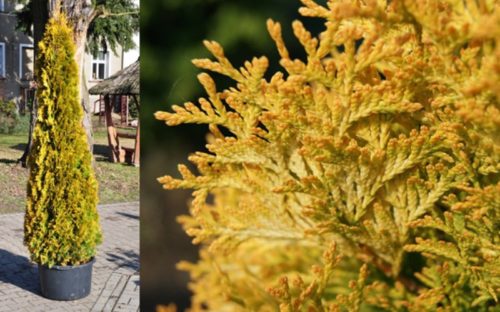
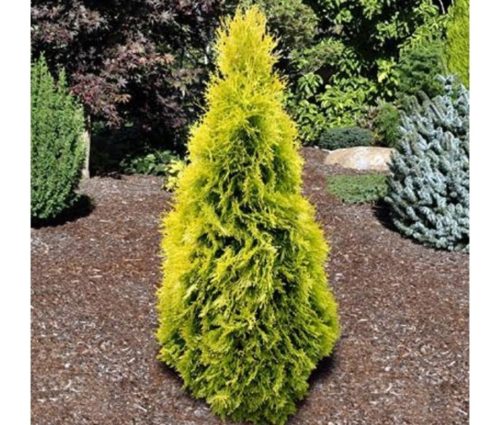
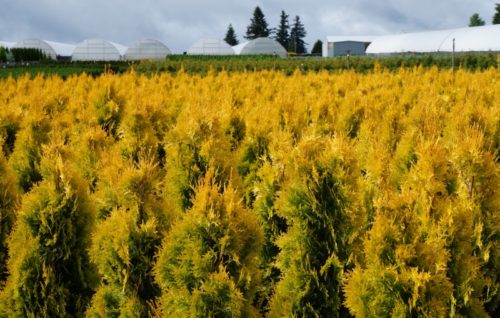
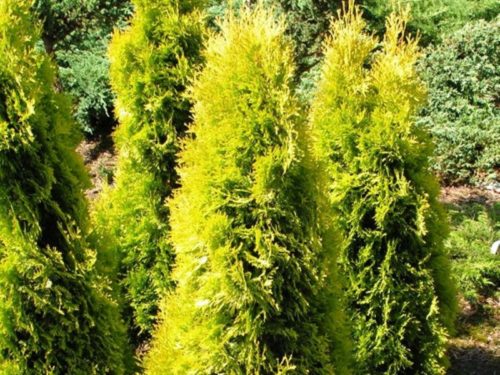
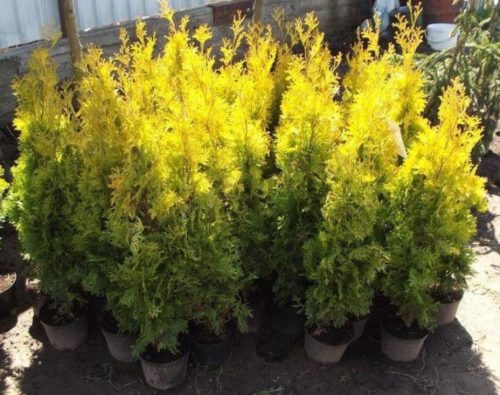

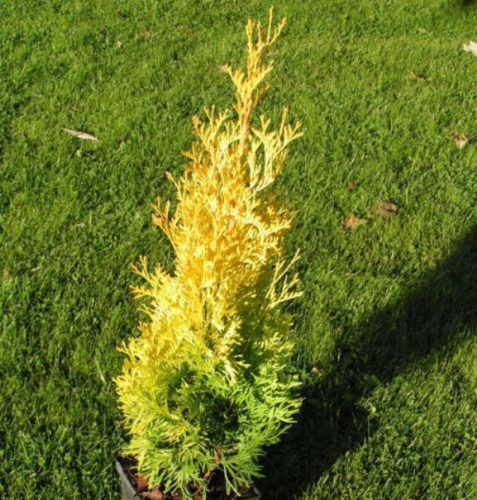
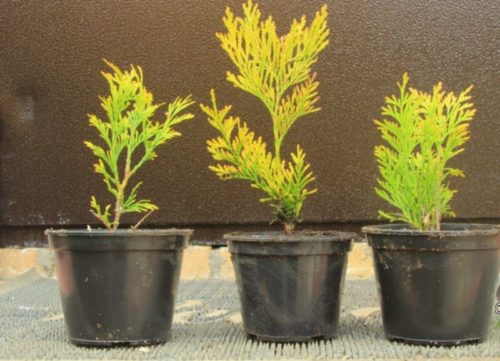
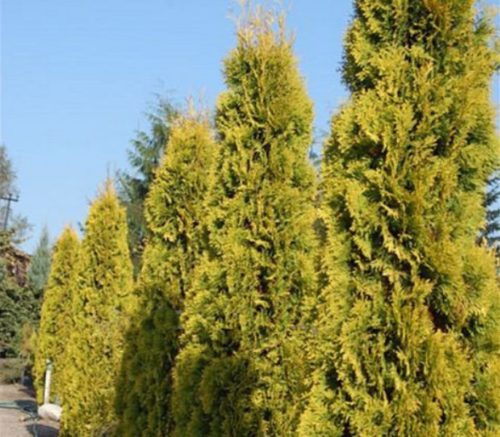












 Start a discussion ...
Start a discussion ...